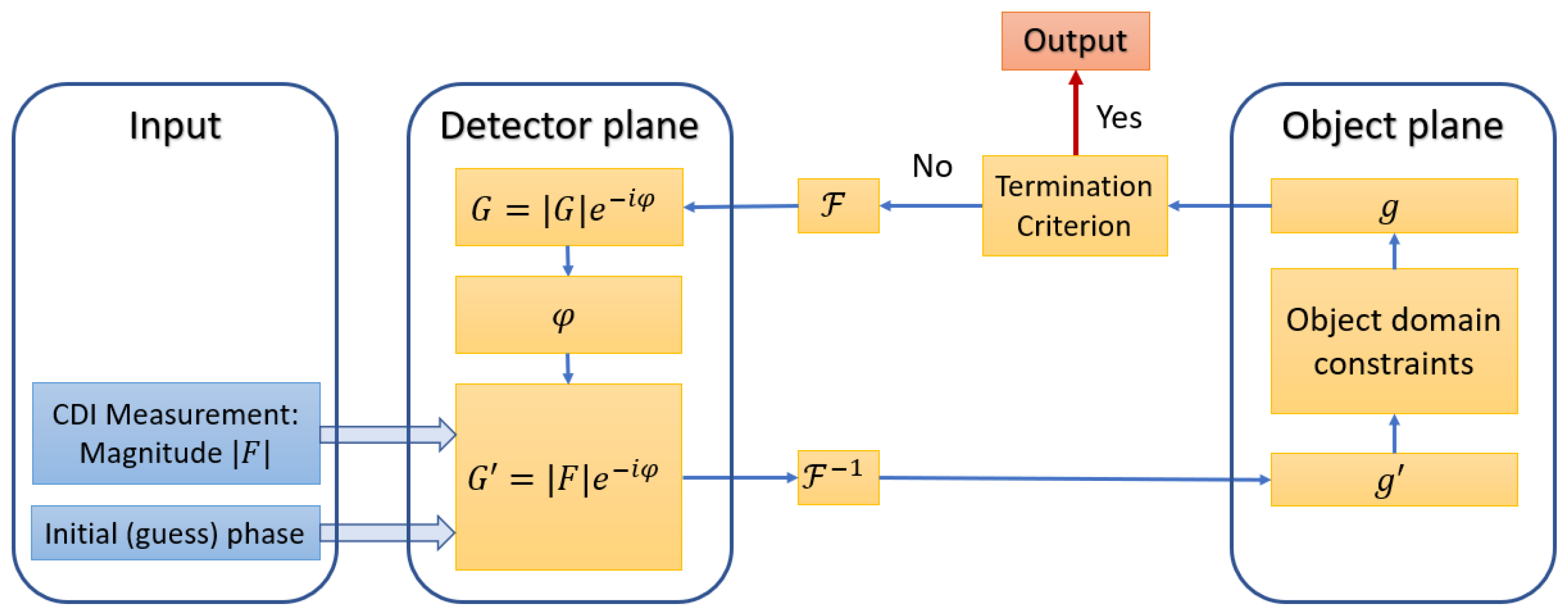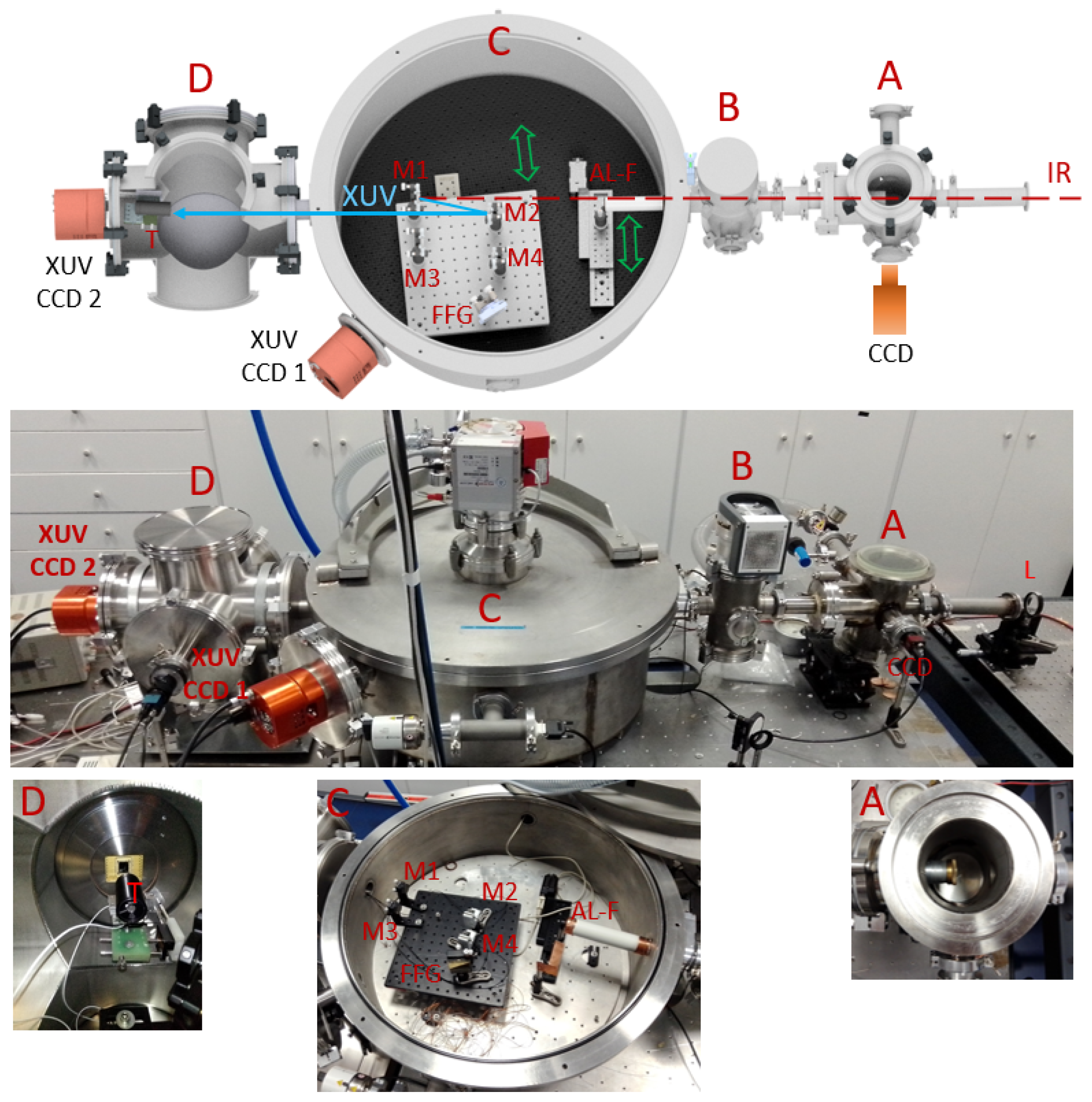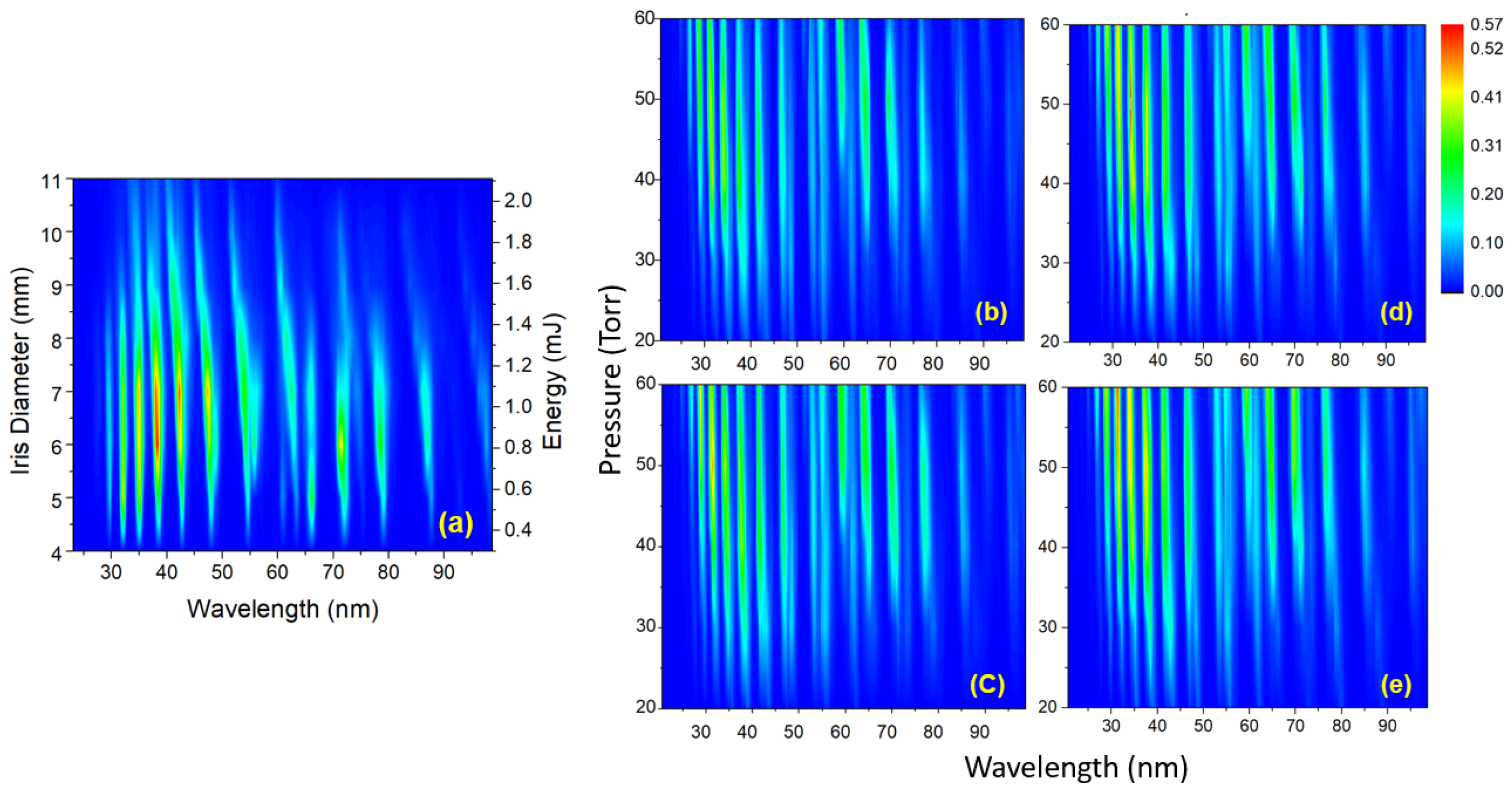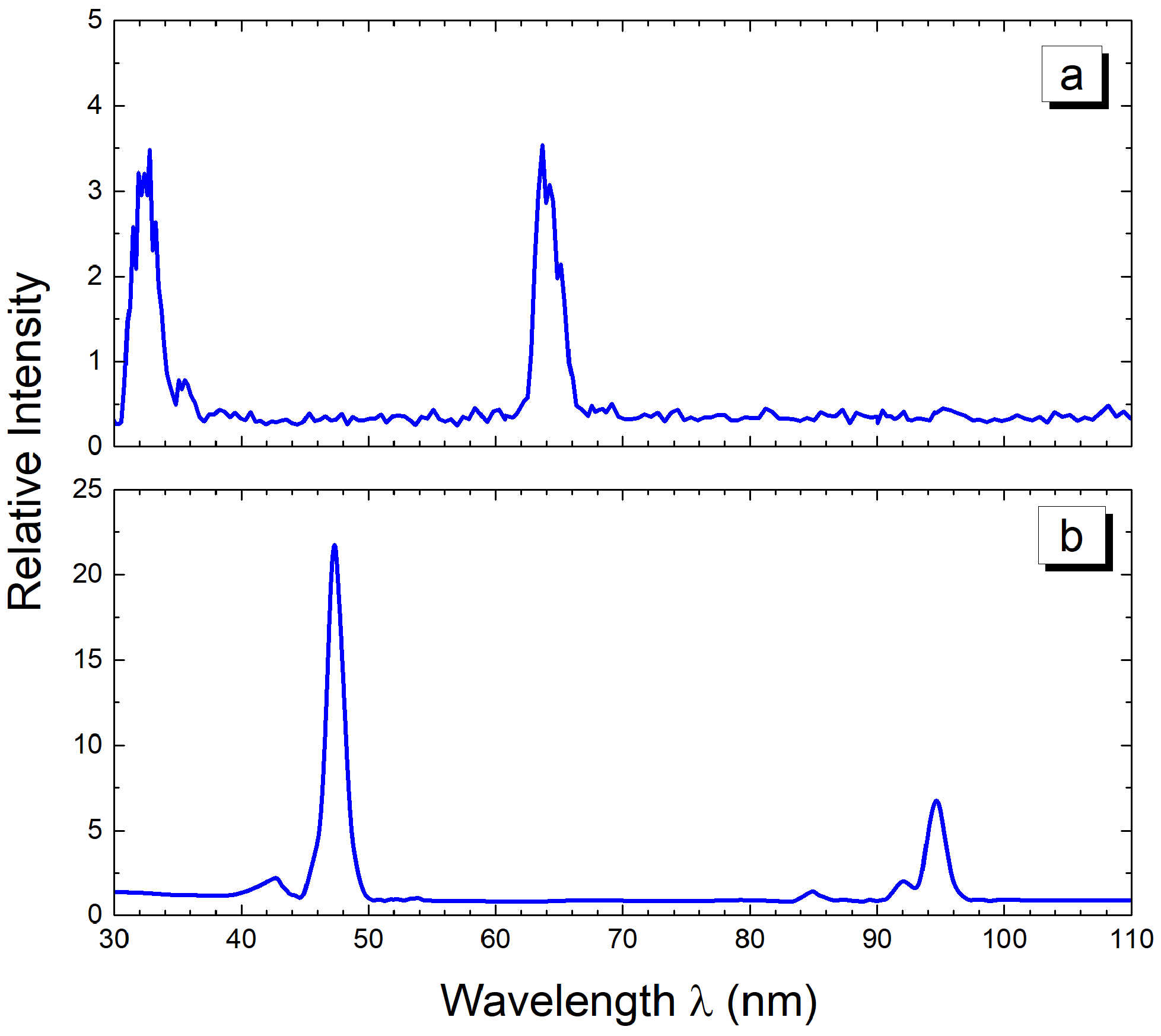Coherent XUV Multispectral Diffraction Imaging in the Microscale
Abstract
:1. Introduction
2. Materials and Methods
2.1. The Experimental Setup
2.2. XUV Optimization Studies
2.2.1. Laser Beam Diameter and Focus Position
2.2.2. Gases
2.2.3. Chirped Laser Pulses
2.2.4. Filtering
2.2.5. XUV Radiation Coherence
3. Results
4. Discussion
Author Contributions
Funding
Institutional Review Board Statement
Informed Consent Statement
Data Availability Statement
Acknowledgments
Conflicts of Interest
Appendix A

Appendix B

References
- Corkum, P.B. Plasma perspective on strong field multiphoton ionization. Phys. Rev. Lett. 1993, 71, 1994–1997. [Google Scholar] [CrossRef] [PubMed] [Green Version]
- Lewenstein, M.; Balcou, P.; Ivanov, M.Y.; L’Huillier, A.; Corkum, P.B. Theory of high-harmonic generation by low-frequency laser fields. Phys. Rev. A 1994, 49, 2117–2132. [Google Scholar] [CrossRef] [PubMed]
- Salières, P.; L’Huillier, A.; Lewenstein, M. Coherence Control of High-Order Harmonics. Phys. Rev. Lett. 1995, 74, 3776–3779. [Google Scholar] [CrossRef] [Green Version]
- Sandberg, R.L.; Paul, A.; Raymondson, D.A.; Hädrich, S.; Gaudiosi, D.M.; Holtsnider, J.; Tobey, R.I.; Cohen, O.; Murnane, M.M.; Kapteyn, H.C.; et al. Lensless Diffractive Imaging Using Tabletop Coherent High-Harmonic Soft-X-Ray Beams. Phys. Rev. Lett. 2007, 99, 098103. [Google Scholar] [CrossRef] [Green Version]
- Zurch, M.; Rothhardt, J.; Hadrich, S.; Demmler, S.; Krebs, M.; Limpert, J.; Tunnermann, A.; Guggenmos, A.; Kleineberg, U.; Spielmann, C. Real-time and Sub-wavelength Ultrafast Coherent Diffraction Imaging in the Extreme Ultraviolet. Sci. Rep. 2014, 4, 7356. [Google Scholar] [CrossRef] [Green Version]
- Miao, J.; Ishikawa, T.; Robinson, I.K.; Murnane, M.M. Beyond crystallography: Diffractive imaging using coherent x-ray light sources. Science 2015, 348, 530–535. [Google Scholar] [CrossRef] [Green Version]
- Gardner, D.F.; Tanksalvala, M.; Shanblatt, E.R.; Zhang, X.; Galloway, B.R.; Porter, C.L.; Karl, R., Jr.; Bevis, C.; Adams, D.E.; Kapteyn, H.C.; et al. Subwavelength coherent imaging of periodic samples using a 13.5 nm tabletop high-harmonic light source. Nat. Photonics 2017, 11, 259–263. [Google Scholar] [CrossRef]
- Roscam Abbing, S.; Campi, F.; Sajjadian, F.S.; Lin, N.; Smorenburg, P.; Kraus, P.M. Divergence Control of High-Harmonic Generation. Phys. Rev. Appl. 2020, 13, 054029. [Google Scholar] [CrossRef]
- Miao, J.; Charalambous, P.; Kirz, J.; Sayre, D. Extending the methodology of X-ray crystallography to allow imaging of micrometre-sized non-crystalline specimens. Nature 1999, 400, 342–344. [Google Scholar] [CrossRef]
- Miao, J.; Sayre, D.; Chapman, H. Phase retrieval from the magnitude of the Fourier transforms of nonperiodic objects. J. Opt. Soc. Am. A 1998, 15, 1662–1669. [Google Scholar] [CrossRef]
- Fienup, J.R. Reconstruction of an object from the modulus of its Fourier transform. Opt. Lett. 1978, 3, 27–29. [Google Scholar] [CrossRef] [PubMed] [Green Version]
- Fienup, J.R. Phase retrieval algorithms: A comparison. Appl. Opt. 1982, 21, 2758–2769. [Google Scholar] [CrossRef] [PubMed] [Green Version]
- Marchesini, S.; He, H.; Chapman, H.N.; Hau-Riege, S.P.; Noy, A.; Howells, M.R.; Weierstall, U.; Spence, J.C. X-ray image reconstruction from a diffraction pattern alone. Phys. Rev. B 2003, 68, 140101. [Google Scholar] [CrossRef] [Green Version]
- Fienup, J.R. Phase retrieval algorithms: A personal tour. Appl. Opt. 2013, 52, 45–56. [Google Scholar] [CrossRef] [Green Version]
- Seaberg, M.D.; Zhang, B.; Gardner, D.F.; Shanblatt, E.R.; Murnane, M.M.; Kapteyn, H.C.; Adams, D.E. Tabletop nanometer extreme ultraviolet imaging in an extended reflection mode using coherent Fresnel ptychography. Optica 2014, 1, 39–44. [Google Scholar] [CrossRef] [Green Version]
- Zhang, B.; Gardner, D.F.; Seaberg, M.D.; Shanblatt, E.R.; Kapteyn, H.C.; Murnane, M.M.; Adams, D.E. High contrast 3D imaging of surfaces near the wavelength limit using tabletop EUV ptychography. Ultramicroscopy 2015, 158, 98–104. [Google Scholar] [CrossRef] [Green Version]
- Tadesse, G.K.; Eschen, W.; Klas, R.; Tschernajew, M.; Tuitje, F.; Steinert, M.; Zilk, M.; Schuster, V.; Zürch, M.; Pertsch, T.; et al. Wavelength-scale ptychographic coherent diffractive imaging using a high-order harmonic source. Sci. Rep. 2019, 9, 1735. [Google Scholar] [CrossRef] [Green Version]
- Tanksalvala, M.; Porter, C.L.; Esashi, Y.; Wang, B.; Jenkins, N.W.; Zhang, Z.; Miley, G.P.; Knobloch, J.L.; McBennett, B.; Horiguchi, N.; et al. Nondestructive, high-resolution, chemically specific 3D nanostructure characterization using phase-sensitive EUV imaging reflectometry. Sci. Adv. 2021, 7, eabd9667. [Google Scholar] [CrossRef]
- Loetgering, L.; Witte, S.; Rothhardt, J. Advances in laboratory-scale ptychography using high harmonic sources. Opt. Express 2022, 30, 4133–4164. [Google Scholar] [CrossRef]
- Kneip, S.; McGuffey, C.; Martins, J.L.; Martins, S.; Bellei, C.; Chvykov, V.; Dollar, F.; Fonseca, R.; Huntington, C.; Kalintchenko, G.; et al. Bright spatially coherent synchrotron X-rays from a table-top source. Nat. Phys. 2010, 6, 980–983. [Google Scholar] [CrossRef]
- Geloni, G.; Saldin, E.; Samoylova, L.; Schneidmiller, E.; Sinn, H.; Tschentscher, T.; Yurkov, M. Coherence properties of the European XFEL. New J. Phys. 2010, 12, 035021. [Google Scholar] [CrossRef]
- Sandberg, R.L.; Song, C.; Wachulak, P.W.; Raymondson, D.A.; Paul, A.; Amirbekian, B.; Lee, E.; Sakdinawat, A.E.; La-O-Vorakiat, C.; Marconi, M.C.; et al. High numerical aperture tabletop soft x-ray diffraction microscopy with 70-nm resolution. Proc. Natl. Acad. Sci. USA 2008, 105, 24–27. [Google Scholar] [CrossRef] [PubMed] [Green Version]
- Raymondson, D.A.; Sandberg, R.L.; Schlotter, W.F.; Raines, K.S.; La-o Vorakiat, C.; Townsend, E.; Sakdinawat, A.; Paul, A.; Miao, J.; Murnane, M.M.; et al. Tabletop coherent diffractive microscopy with extreme ultraviolet light from high harmonic generation. In Proceedings of the Metrology, Inspection, and Process Control for Microlithography XXIII, SPIE, San Jose, CA, USA, 22–27 February 2009; Volume 7272, pp. 126–133. [Google Scholar] [CrossRef]
- Ravasio, A.; Gauthier, D.; Maia, F.; Billon, M.; Caumes, J.; Garzella, D.; Géléoc, M.; Gobert, O.; Hergott, J.F.; Pena, A.; et al. Single-shot diffractive imaging with a table-top femtosecond soft x-ray laser-harmonics source. Phys. Rev. Lett. 2009, 103, 028104. [Google Scholar] [CrossRef] [PubMed]
- Dinh, K.B.; Ong, A.X.; Le, H.V.; Henderson, C.A.; Van Vuong, C.; Hannaford, P.; Smith, T.A.; Van Dao, L. Coherent diffractive imaging of single layer microspheres. J. Appl. Phys. 2015, 117, 163102. [Google Scholar] [CrossRef]
- Truong, N.X.; Strashnov, I.; Whittaker, E.; Zhong, X.L.; Denecke, M.A. Coherent diffractive imaging of graphite nanoparticles using a tabletop EUV source. Phys. Chem. Chem. Phys. 2017, 19, 29660–29668. [Google Scholar] [CrossRef]
- Eschen, W.; Loetgering, L.; Schuster, V.; Klas, R.; Kirsche, A.; Berthold, L.; Steinert, M.; Pertsch, T.; Gross, H.; Krause, M.; et al. Material-specific high-resolution table-top extreme ultraviolet microscopy. Light. Sci. Appl. 2022, 11, 117. [Google Scholar] [CrossRef]
- Gauthier, D.; Guizar-Sicairos, M.; Ge, X.; Boutu, W.; Carré, B.; Fienup, J.; Merdji, H. Single-shot femtosecond X-ray holography using extended references. Phys. Rev. Lett. 2010, 105, 093901. [Google Scholar] [CrossRef]
- Rothhardt, J.; Tadesse, G.K.; Eschen, W.; Limpert, J. Table-top nanoscale coherent imaging with XUV light. J. Opt. 2018, 20, 113001. [Google Scholar] [CrossRef]
- Tadesse, G.K.; Klas, R.; Demmler, S.; Hädrich, S.; Wahyutama, I.; Steinert, M.; Spielmann, C.; Zürch, M.; Pertsch, T.; Tünnermann, A.; et al. High speed and high resolution table-top nanoscale imaging. Opt. Lett. 2016, 41, 5170–5173. [Google Scholar] [CrossRef]
- Papadogiannis, N.; Kalpouzos, C.; Goulielmakis, E.; Nersisyan, G.; Charalambidis, D.; Auge, F.; Weihe, F.; Balcou, P. Kilohertz extreme-ultraviolet light source based on femtosecond high-order harmonic generation from noble gases. Appl. Phys. B 2001, 73, 687–692. [Google Scholar] [CrossRef]
- Balas, C.; Epitropou, G.; Pappas, C. Multi/Hyper-Spectral Imaging. In Handbook of Biomedical Optics; CRC Press: Boca Raton, FL, USA, 2011. [Google Scholar]
- Balas, C.; Epitropou, G.; Tsapras, A.; Hadjinicolaou, N. Hyperspectral Imaging and Spectral Classification for Pigment Identification and Mapping in Paintings by El Greco and his Workshop. In Multimedia Tools and Applications; Springer: Berlin/Heidelberg, Germany, 2018; pp. 1–17. [Google Scholar]
- Boldrini, B.; Kessler, W.; Rebner, K.; Kessler, R.W. Hyperspectral Imaging: A Review of Best Practice, Performance and Pitfalls for in-line and on-line Applications. J. Infrared Spectrosc. 2012, 20, 483–508. [Google Scholar] [CrossRef]
- Dong, X.; Jakobi, M.; Wang, S.; Köhler, M.H.; Zhang, X.; Koch, A.W. A review of hyperspectral imaging for nanoscale materials research. Appl. Spectrosc. Rev. 2019, 54, 285–305. [Google Scholar] [CrossRef]
- Clark, E.L.; Grigoriadis, A.; Petrakis, S.; Tazes, I.; Andrianaki, G.; Skoulakis, A.; Orphanos, Y.; Kaselouris, E.; Fitilis, I.; Chatzakis, J.; et al. High-intensity laser-driven secondary radiation sources using the ZEUS 45 TW laser system at the Institute of Plasma Physics and Lasers of the Hellenic Mediterranean University Research Centre. High Power Laser Sci. Eng. 2021, 9, e53. [Google Scholar] [CrossRef]
- Kazamias, S.; Weihe, F.; Douillet, D.; Valentin, C.; Planchon, T.; Sebban, S.; Grillon, G.; Auge, F.; Hulin, D.; Balcou, P. High order harmonic generation optimization with an apertured laser beam. Eur. Phys. J. D 2002, 21, 353–359. [Google Scholar] [CrossRef]
- Lee, D.G.; Kim, J.H.; Hong, K.H.; Nam, C.H. Coherent Control of High-Order Harmonics with Chirped Femtosecond Laser Pulses. Phys. Rev. Lett. 2001, 87, 243902. [Google Scholar] [CrossRef] [Green Version]
- Kim, J.H.; Nam, C.H. Plasma-induced frequency chirp of intense femtosecond lasers and its role in shaping high-order harmonic spectral lines. Phys. Rev. A 2002, 65, 033801. [Google Scholar] [CrossRef] [Green Version]
- Carlström, S.; Preclíková, J.; Lorek, E.; Larsen, E.W.; Heyl, C.M.; Paleček, D.; Zigmantas, D.; Schafer, K.J.; Gaarde, M.B.; Mauritsson, J. Spatially and spectrally resolved quantum path interference with chirped driving pulses. New J. Phys. 2016, 18, 123032. [Google Scholar] [CrossRef]
- Petrakis, S.; Bakarezos, M.; Tatarakis, M.; Benis, E.P.; Papadogiannis, N.A. Electron quantum path control in high harmonic generation via chirp variation of strong laser pulses. Sci. Rep. 2021, 11, 23882. [Google Scholar] [CrossRef] [PubMed]
- Petrakis, S.; Bakarezos, M.; Tatarakis, M.; Benis, E.P.; Papadogiannis, N.A. Spectral and Divergence Characteristics of Plateau High-Order Harmonics Generated by Femtosecond Chirped Laser Pulses in a Semi-Infinite Gas Cell. Atoms 2022, 10, 53. [Google Scholar] [CrossRef]
- Willner, A.; Tavella, F.; Yeung, M.; Dzelzainis, T.; Kamperidis, C.; Bakarezos, M.; Adams, D.; Schulz, M.; Riedel, R.; Hoffmann, M.C.; et al. Coherent Control of High Harmonic Generation via Dual-Gas Multijet Arrays. Phys. Rev. Lett. 2011, 107, 175002. [Google Scholar] [CrossRef] [Green Version]
- Willner, A.; Tavella, F.; Yeung, M.; Dzelzainis, T.; Kamperidis, C.; Bakarezos, M.; Adams, D.; Riedel, R.; Schulz, M.; Hoffmann, M.C.; et al. Efficient control of quantum paths via dual-gas high harmonic generation. New J. Phys. 2011, 13, 113001. [Google Scholar] [CrossRef] [Green Version]
- Fienup, J.R.; Wackerman, C.C. Phase-retrieval stagnation problems and solutions. J. Opt. Soc. Am. A 1986, 3, 1897–1907. [Google Scholar] [CrossRef]







Publisher’s Note: MDPI stays neutral with regard to jurisdictional claims in published maps and institutional affiliations. |
© 2022 by the authors. Licensee MDPI, Basel, Switzerland. This article is an open access article distributed under the terms and conditions of the Creative Commons Attribution (CC BY) license (https://creativecommons.org/licenses/by/4.0/).
Share and Cite
Petrakis, S.; Skoulakis, A.; Orphanos, Y.; Grigoriadis, A.; Andrianaki, G.; Louloudakis, D.; Kortsalioudakis, N.; Tsapras, A.; Balas, C.; Zouridis, D.; et al. Coherent XUV Multispectral Diffraction Imaging in the Microscale. Appl. Sci. 2022, 12, 10592. https://doi.org/10.3390/app122010592
Petrakis S, Skoulakis A, Orphanos Y, Grigoriadis A, Andrianaki G, Louloudakis D, Kortsalioudakis N, Tsapras A, Balas C, Zouridis D, et al. Coherent XUV Multispectral Diffraction Imaging in the Microscale. Applied Sciences. 2022; 12(20):10592. https://doi.org/10.3390/app122010592
Chicago/Turabian StylePetrakis, Stylianos, Alexandros Skoulakis, Yannis Orphanos, Anastasios Grigoriadis, Georgia Andrianaki, Dimitrios Louloudakis, Nathanail Kortsalioudakis, Athanasios Tsapras, Costas Balas, Dimitrios Zouridis, and et al. 2022. "Coherent XUV Multispectral Diffraction Imaging in the Microscale" Applied Sciences 12, no. 20: 10592. https://doi.org/10.3390/app122010592






